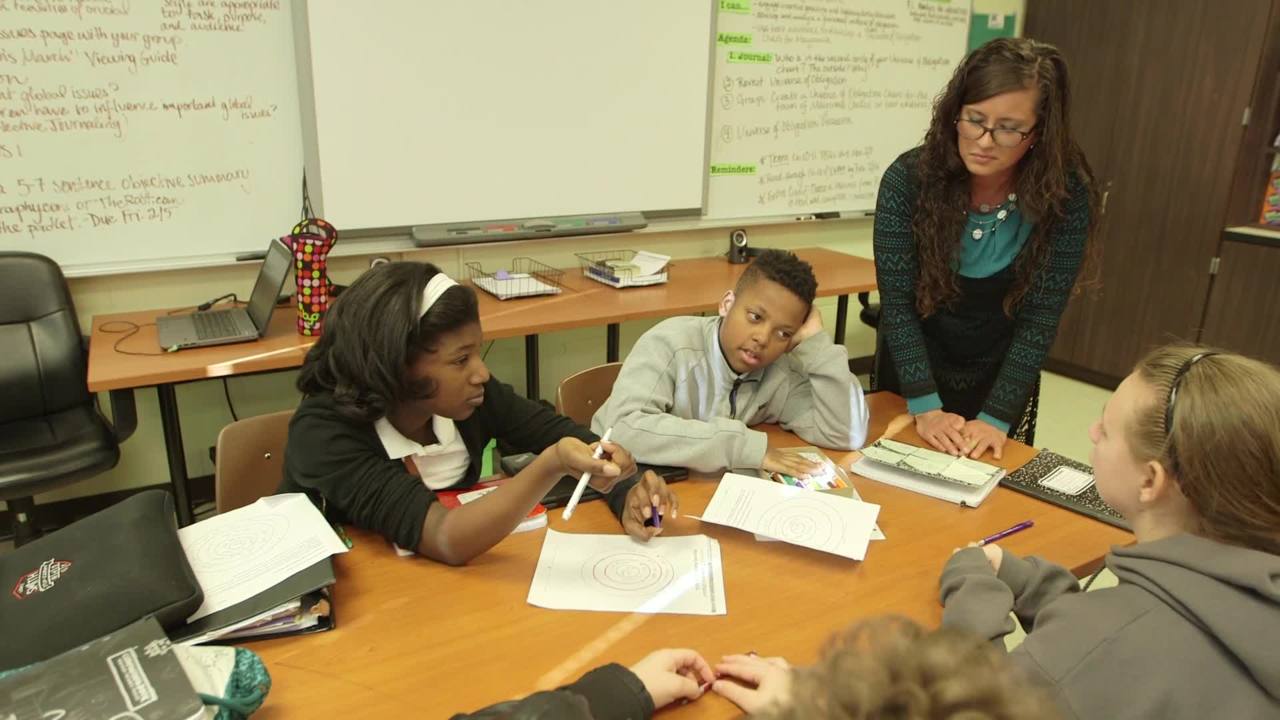One way to help students understand the moral universe of a community such as Maycomb in To Kill a Mockingbird is by introducing the concept of universe of obligation, a term coined by scholar Helen Fein. A universe of obligation is the circle of individuals and groups toward whom obligations are owed, to whom rules apply, and whose injuries call for amends. In other words, those that a society believes have rights that are worthy of respect and protection.
So we are currently on Section 3 of Teaching Mockingbird, which runs from Chapter 8 through Chapter 11. So we're a little bit into the book. Today, I have the students broken into four groups. And each group is going to work together to create a universe of obligation chart for the town of Maycomb.
Handout 3.1, called "Universe of Obligation, Maycomb, Alabama in the 1930s," is a handout that provides a graphic organizer of concentric circles that can help students map Maycomb's universe of obligation in more detail. Prompt them to start inside the circle, circle number one, and describe there the residents of Maycomb who received the most respect and protection from the community's spoken and unspoken rules. They can add descriptions of those who received different levels of respect and protection to each of the next three levels in the diagram. If there are any residents of Maycomb who they believe don't receive any respect or protection, students can write them outside of the outermost circle.
That's a little bit of a lofty concept. How do you make a setting a person, if you will? So we're going to have Maycomb in the middle. And who would Maycomb consider important? And who would they leave out of their obligation?
And then we'll come back together and discuss it as a class. Do we all have different characters that we placed in the same circle in the chart? And why was that? And of course I'll have them reference the text and back themselves up with what they read.
Essentially guys, just remember, as you move further out into the larger circles, those are people less connected and less protected by the town of Maycomb, all right? What I do ask that you consider is the text, and the words that Harper Lee uses. I know that you've got your own opinions about these people in the book, as do I. But let's really try to base this back on the text. What does the text say?
What about Calpurnia?
I consider her part of the Finches.
I consider her part of the Finches, too.
I think it's hard.
It is hard.
Because she's black.
I haven't, exactly, figured out what Maycomb exactly thinks of her.
After the groups create the Maycomb universe of obligation chart, we're going to discuss a few overarching questions. What does it mean to be on the inside of a universe of obligation chart? And then, what does it mean to be on the outside? How were those decisions made, and how does it affect the people on the inside and on the outside?
And of course, being a Common Core-based lesson, the students aren't just going to arbitrarily list characters. They're going to have to revisit the text in order to place them in the chart.
OK guys, thank you. So I would love to come back together and have each group share where you've got people placed, OK? I've got some interesting conversations that I witnessed.
And I've got a couple of what I'm going to call outliers, a couple groups who placed people where no other group did, OK, so where no other people have been placed before. So yes, I want to talk about that. I want to talk about why, all right?
So let me start back with Nolan's group. So everybody should have Maycomb in one, because this is the chart. It's about Maycomb. And that was kind of hard, right?
Raise your hand if you guys had to grapple with, is this about Maycomb or are we looking at the Finches. OK, thank you for admitting that, three groups. Because it is kind of hard, right? Because we're getting the perspective of whom as the narrator?
Scout.
Scout Finch, right? So you've got to separate yourself from the narrator, and step into the skin, right? Of this city.
I saw a hand over here. You all have someone else in two?
Kind of.
We have Calpurnia, but we put her--
Between two and three
--in between two and three.
Because she's a Finch, but she's still black, and she still works for them. So we put her in between two and three because it doesn't exactly balance out in the city. Because we don't exactly know how people of Maycomb view Calpurnia, yet. Because we haven't gotten that far in the book. So we put her in between two and three.
Awesome.
We put the Cunninghams.
They have just the Cunninghams in circle three.
And the Finches.
The Cunninghams and the Finches, interesting. Right?
So what I'd like to do-- you guys are awesome. You're having a great, great discussion. Telling us, me and your classmates, why you're placing people in different places. And I love how even though we have differing opinions, each opinion is what, Erica? Backed up by--
Evidence.
Evidence. OK, awesome. So what I'd like to do to conclude class today is just talk about some of these overarching questions about universe of obligation in general. Of course, thinking of what you just did, and then the one that you created yesterday for yourself.
But how does a community determine who belongs and who does not? A community. OK, Erica?
Well, it kinda seems like it depends on how well-known the person is. And like you said, it depends on their actions. Because if they do a certain thing, they'll become well-known, and it will be based on all the rumors that have been spread.
Kind of like with Boo Radley. No one knows if he actually did all the stuff that they said in the book. Like they said he stabbed his father with some scissors in his leg, and bad things like that. But no one really isn't sure if it's true or not. So they can't base that.
OK.
I hope that what they see is that this early in the text, things have been preset in the town of Maycomb for generations. And that there are going to be certain groups that are close, that are well thought of, and certain groups that have always been on the outside.
Now, what happens is, in a couple sections we're going to revisit, again, the universe of obligation, once the trial has started. And see how things have shifted. Because you do see a shift.
You have groups of people move closer toward the inside, and closer toward the middle of the obligation chart. And then you have other groups move further to the outside. And why is there that shift? And then the broad question of, can your universe of obligation, personally, shift? Or is it always set in stone.














